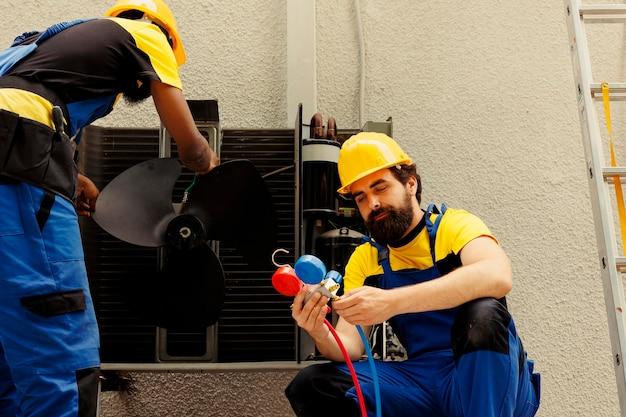Are you wondering if compressed air can be used to clean the coils of your refrigerator? Well, you’re not alone! Refrigerator maintenance is essential to keep it running efficiently and extend its lifespan. Dirty coils can hinder the cooling process and strain the refrigerator’s compressor, leading to decreased performance and higher energy consumption. However, before you grab that can of compressed air, it’s important to understand the dos and don’ts of cleaning refrigerator coils.
In this blog post, we will delve into the topic of using compressed air to clean refrigerator coils and explore the potential benefits and risks involved. We will also address other common questions related to refrigerator temperature control, such as the ideal temperature setting and what happens when the coils are dirty. So, let’s dive in and demystify this important aspect of refrigerator maintenance!
Can I Use Compressed Air to Clean Refrigerator Coils
So you’ve noticed that your fridge doesn’t seem as cool as it used to be. Before you start panicking and contemplating a trip to the appliance store, there might be a simple solution to your problem: cleaning the refrigerator coils. But hold on a second, can you use compressed air to do this? Let’s dive in and find out!
Understanding the Importance of Clean Coils
Before we delve into the topic of using compressed air, let’s first understand why clean coils are important. You see, the refrigerator coils are responsible for releasing heat from inside the fridge, allowing it to maintain a cool temperature. Over time, these coils can gather dust, dirt, and even pet hair, reducing their efficiency and making the fridge work harder to keep things cold. In turn, this increases energy consumption and can shorten the lifespan of your refrigerator. No one wants to say goodbye to their trusty kitchen companion prematurely, right?
The Pros and Cons of Compressed Air Cleaning
Now, let’s talk about using compressed air to tackle those dirty coils. On one hand, compressed air can be a handy tool for blowing away stubborn debris from the coils. It’s quick, efficient, and can reach those hard-to-access areas. Plus, it gives you an excuse to use your “serious” tools, making you feel like a superhero with a mission to save the day!
However, before you rush to the garage and grab your air compressor, it’s essential to consider the cons as well. One potential drawback is that using compressed air can actually push the dirt and dust further into the coils, creating an even bigger problem. Another concern is the potential damage that high-pressure air can cause to delicate components in your fridge. We don’t want to go from a dirty coil situation to a broken fridge crisis, do we?
Proceeding with Caution
If you’ve weighed the pros and cons and decided to give the compressed air method a shot, here’s some advice to ensure you proceed with caution. Disclaimer: Only attempt this if you’re comfortable and confident in your abilities. If you’re unsure, it’s always better to call a professional. Safety first, folks!
-
Gather Your Tools: Get your trusty air compressor ready, along with safety goggles and a face mask. It’s about to get dusty in there!
-
Disconnect the Fridge: Safety first! Start by unplugging the fridge and giving it time to cool down. You don’t want any accidental finger-freezing moments mid-cleaning.
-
Locate the Coils: Depending on your refrigerator model, the coils can be found either on the back or underneath. Refer to your fridge’s user manual for specific instructions if needed. A flashlight might come in handy too.
-
Clear the Space: Clear any clutter around the coils, ensuring a smooth cleaning operation. The dust bunnies need space to roam freely!
-
Blow the Dust Away: Don your safety gear and slowly blow compressed air across the coils, focusing on the dirtiest areas. Keep a safe distance to avoid damaging any delicate parts. Give those coils a breath of fresh air!
-
Check and Double Check: After the cleaning party is over, take a moment to inspect the coils. Ensure they’re free from dirt and debris. If necessary, use a soft brush or cloth to gently remove any lingering particles.
When in Doubt, Seek Professional Help!
If you’re not the DIY type or simply feel unsure about the compressed air cleaning method, it’s wise to seek professional assistance. Refrigerators are valuable—and oftentimes pricey—appliances, deserving of expert care. Don’t be afraid to call in the cavalry and let the professionals work their magic. After all, it’s better to be safe than sorry!
So there you have it—a comprehensive guide to the question of using compressed air to clean refrigerator coils. Just remember to weigh the pros and cons before diving into the dusty adventure, follow safety precautions, and consider seeking professional help if needed. With proper maintenance, your fridge will continue to keep your food fresh and your kitchen running smoothly, making you the true hero of your household!
Now go forth and conquer those coils, fellow fridge enthusiasts!
FAQ: Can I Use Compressed Air to Clean Refrigerator Coils
Is 5 or 1 Colder on a Fridge
The temperature settings on your fridge can sometimes be a bit puzzling. Is 5 colder than 1? The truth is, these numbers don’t directly correlate to temperature. They are simply arbitrary settings used by manufacturers. To determine the actual temperature inside your fridge, it’s best to use an independent thermometer.
How Do I Know If My Fridge is Cold Enough Without a Thermometer
If you find yourself without a thermometer, there’s still a way to gauge whether your fridge is cold enough. Your perishable foods, such as milk and meat, should feel cold to the touch. Additionally, if your ice cream is as solid as a block of ice and your beverages are refreshingly chilled, you’ve likely achieved the optimal temperature.
Why Does the Fridge Freeze
Discovering your lettuce has transformed into a solid iceberg is certainly a chilling experience (pun intended). There could be a couple of reasons for this unfortunate event. One possibility is that the thermostat is set too low, causing the fridge to plunge into sub-zero temperatures. Another culprit might be a faulty temperature control system. In either case, it’s important to address the issue promptly to prevent further frozen mishaps.
How Does Refrigerator Temperature Control Work
Ah, the fascinating world of refrigerator temperature control! To keep things cool (literally), refrigerators use a temperature control system that involves a thermostat and a compressor. When the internal temperature rises above the desired level, the thermostat sends a signal to the compressor, which then activates and starts cooling the fridge. Once the temperature reaches the set point, the compressor takes a break until it’s needed again. It’s a delicate dance between warmth and chill!
Can I Use Compressed Air to Clear Refrigerator Coils
Using compressed air to clean refrigerator coils can be as satisfying as watching a dusty piano get a good ol’ tune-up. However, it’s important to exercise caution. While compressed air can effectively remove dirt and debris from the coils, be mindful not to damage any delicate components or bend the coils out of shape. If you’re unsure about the process, it’s always wise to consult the manufacturer’s guidelines or seek the help of a professional.
Is a Fridge More Efficient Full or Empty
Now, this may come as a surprise, but your fridge actually prefers a full house! When your refrigerator is stocked with food and beverages, the items act as thermal mass, helping to stabilize and maintain the temperature inside. This means that whenever you open the fridge door to grab a snack, the cool air has less empty space to escape, resulting in reduced energy waste. So, go on and stock up your fridge – it will thank you for the company!
What Can I Use to Clean Condenser Coils
Ah, cleaning those condenser coils—everyone’s favorite chore! To keep your condenser coils in tiptop shape, a soft bristle brush can come to the rescue. Gently brush away the accumulated dust and dirt, being cautious not to damage any surrounding components. Remember, a little cleaning now can go a long way in maintaining the efficiency and longevity of your fridge.
What Happens If Refrigerator Coils Are Dirty
When refrigerator coils are in dire need of a cleaning, they become like a clogged highway during rush hour. Dirt and debris build up on the coils, obstructing the flow of heat away from the fridge. This causes the compressor to work harder, leading to increased energy consumption and even potential system failure. So, make sure to show those coils some love and keep them spick and span!
What Is the Best Temperature for a Refrigerator
Finding the sweet spot for your refrigerator temperature is key to ensuring the freshness of your food. According to food safety guidelines, the optimal temperature for your fridge should be below 5°C (41°F). This temperature range inhibits the growth of bacteria and helps to preserve your groceries for longer. Plus, it keeps your beverages just the right amount of frosty for maximum enjoyment.
Now that you’re armed with knowledge about cleaning refrigerator coils with compressed air, understanding fridge temperature settings, and even the preferred occupancy status of your fridge, you can confidently tackle any cooling conundrums that come your way! So, go forth and keep your fridge cool while enjoying all the delicious treats it holds. Stay frosty!

